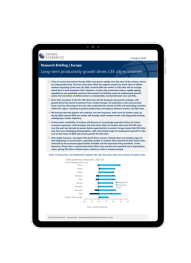Long-term productivity growth drives CEE city economies

Cities in central and eastern Europe (CEE) have grown rapidly since the start of the century, driven by rising productivity. That has more than offset the negative impact for these cities of skilled workers migrating to the west. By 2050, nominal GDP per worker in CEE cities will on average match that in west European cities.
What you will learn:
- Since their accession to the EU, CEE cities have led the European city growth rankings, with growth driven by inward investment from western Europe.
- We forecast that this pattern will continue over the long term, with room for further catch-up. But by 2050 nominal GDP per worker will broadly match western levels, with disposable incomes undergoing a similar trajectory.
- At that point, availability of workers will become an increasingly important factor for future economic expansion. Unfortunately, the brain drain effect of workers who have left CEE cities over the past two decades to pursue better opportunities in western Europe means that CEE cities may face very challenging demographics, with only limited scope for employment growth to take over as the motor of GDP and income growth for CEE cities.
- That might, however, not apply if the brain drain reverses. Already there are tentative signs of that happening. In recent years, a growing number of workers have returned to their home cities, attracted by the increased opportunities available and the improved living standards.
Tags:
You may be interested in

Post
Good Practices in the Provision of Global Public Goods: How multilateral development banks build on global public goods in their operations
In our flagship report, ‘Multilateral Development Banks for Global Public Goods’, commissioned by Deutsche Gesellschaft für Internationale Zusammenarbeit on behalf of the German Federal Ministry for Economic Cooperation and Development, Oxford Economics highlighted the positive role that the use of GPGs can play in preventing and addressing crises that cross national boundaries. As part of that work, we wanted to identify and share promising practices and good examples of how the provision of GPGs can be supported through international funding—and in particular through MDBs.
Find Out More
Post
Europe: City employment growth eases, but office sectors still lead
Labour markets in European cities have shown remarkable resilience over the last few years, and employment in office-based sectors especially so. But from this year onwards, we expect the pace of office employment growth to slow.
Find Out More
Post
Key themes shaping the outlook for city economies under different climate policies
We have modelled the regional economic implications of a range of policies that governments could impose to support the transition toward net zero. Under each scenario the future economic outlook of cities and regions will vary, with some places benefitting, while others will undoubtedly lose out.
Find Out More